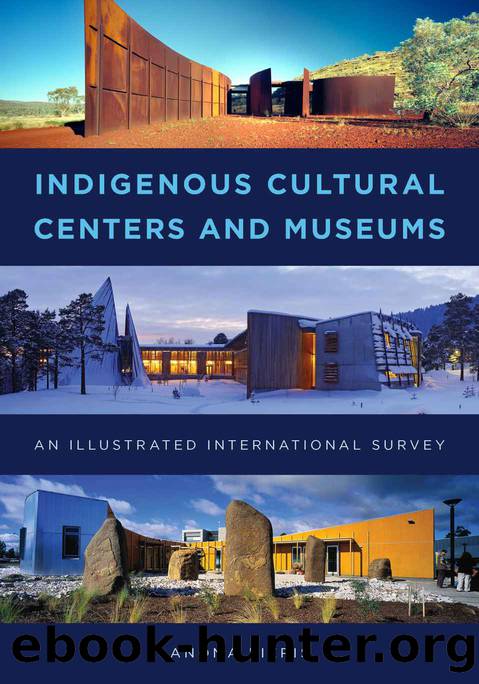Indigenous Cultural Centers and Museums by Pieris Anoma;

Author:Pieris, Anoma; [Pieris, Anoma]
Language: eng
Format: epub
Publisher: Rowman & Littlefield Unlimited Model
Published: 2016-05-19T04:00:00+00:00
Figure 20.2. Musée du Quai Branly, Université building, interior. Photo by author, 2011.
While these commissioned works decorate quotidian spaces, the Aboriginal artworks displayed within the Museum comprise bark painting collected at the instigation of Karel Kupka, along with acrylic paintings acquired since the 1970s. Both these art forms are collected for their artistic rather than ethnographic value, an approach that can be interpreted as elevating them into equivalence with other artworks. The ceiling paintings can be argued in a similar light, although they are reduced to visual patterns. These questions service the opposite side of the debate between art and ethnography. Art in this interpretation elevates the ethnographic object while ethnography gives art added layers of meaning.
Reception
The jury citation for the Pritzker Architecture Prize 2008, awarded to Jean Nouvel, describes the Musée du Quai Branly as âa bold, unorthodox building with unusual spaces in which objects are displayedâand understoodâin new ways.â14 The Museumâs director, Stéphane Martin, is quoted as describing the space as a theater.15 The decontextualization of the artifacts has been much criticized. A review of several debates on postcolonial museum practice included in the book Paris Primitive provides insights into the underlying politics: the postcolonial museum evolves from problematic colonial collection practices, which are often suppressed when historical objects are represented as art.16 The museum landscape is largely oriented toward a bourgeois European public, and the task of the postcolonial museum, critics argue, is to expose the stories of imperial history and its resilient politics of difference, and to engage with culturally diverse audiences nationally and internationally.17
The Musée du Quai Branly has developed extensive pedagogical and public outreach programs, including conferences, workshops, exhibitions, performances, and publications, with the intention of facilitating âdialogues between cultures.â18 It has launched programs and exhibitions featuring transnational Indigenous communities, many of them from former colonies. More recently, extramural programs framed as Les Ateliers Nomades (nomadic or transient workshops) diversifies its metropolitan reach. The program for 2014 and 2015 includes collaborative activities in the economically marginal, âimmigrantâ Paris suburbs of Clichy-sous-Bois and Montfermeil.19
Notes
1. Thanks to curator Magali Melandri for an interview held in September 2010. Image use permissions via Scala, London.
2. Alexandra Sauvage, âNarratives of Colonisation: The Musée du Quai Branly in Context,â reCollections: Journal of the National Museum of Australia 2, no. 2 (September 2007), available at http://recollections.nma.gov.au/issues/vol_2_no2/papers/narratives_of_colonisation/.
3. Michael Kimmelman, âA Heart of Darkness in the City of Light,â New York Times, July 2, 2006.
4. Kimmelman, âA Heart of Darkness in the City of Light.â
5. Summary of description from Pierre Engel, Case Studies: Quai Branly Museum.
6. Pierre Engel, âQuai Branly Museum,â Arcellor Mittal, available at http://www.constructalia.com/english/case_studies/france/quai_branly_museum#.VjsL_64rKRs.
7. Fiâs Growing Gardening and Design, âMusee du Quai Branly,â available at http://growingardeningdesign.blogspot.com/2010/08/musee-du-quai-branly.html.
8. Pierre Engel, âQuai Branly Museum.â
9. France Diplomatie, âDossiers: Official StatementâThe Quai Branly Museum: A New Institution Engaged in the Dialogue of Cultures and Civilizations,â available at http://www.diplomatie.gouv.fr/en/france_159/discovering-france_2005/france-from-to-z_1978/culture_1979/the-musee-du-quai-branly_5035.html.
10. Agnès Blasselle and Anna Guarneri, âThe Opening of the Musée du Quai Branly: Valuing/Displaying the âOtherâ in Post-Colonial France,â Humanity in Action, available at http://www.humanityinaction.org/knowledgebase/200-the-opening-of-the-musee-du-quai-branly-valuing-displaying-the-other-in-post-colonial-france.
11. Sauvage, âNarratives of Colonisation.
Download
This site does not store any files on its server. We only index and link to content provided by other sites. Please contact the content providers to delete copyright contents if any and email us, we'll remove relevant links or contents immediately.
| Anthropology | Archaeology |
| Philosophy | Politics & Government |
| Social Sciences | Sociology |
| Women's Studies |
Cecilia; Or, Memoirs of an Heiress — Volume 1 by Fanny Burney(32075)
Cecilia; Or, Memoirs of an Heiress — Volume 3 by Fanny Burney(31469)
Cecilia; Or, Memoirs of an Heiress — Volume 2 by Fanny Burney(31419)
The Great Music City by Andrea Baker(30797)
We're Going to Need More Wine by Gabrielle Union(18641)
All the Missing Girls by Megan Miranda(14788)
Pimp by Iceberg Slim(13798)
Bombshells: Glamour Girls of a Lifetime by Sullivan Steve(13698)
Fifty Shades Freed by E L James(12925)
Talking to Strangers by Malcolm Gladwell(12888)
Norse Mythology by Gaiman Neil(12861)
For the Love of Europe by Rick Steves(11558)
Crazy Rich Asians by Kevin Kwan(8898)
Mindhunter: Inside the FBI's Elite Serial Crime Unit by John E. Douglas & Mark Olshaker(8721)
The Lost Art of Listening by Michael P. Nichols(7170)
Enlightenment Now: The Case for Reason, Science, Humanism, and Progress by Steven Pinker(6879)
The Four Agreements by Don Miguel Ruiz(6326)
Bad Blood by John Carreyrou(6284)
Weapons of Math Destruction by Cathy O'Neil(5846)
